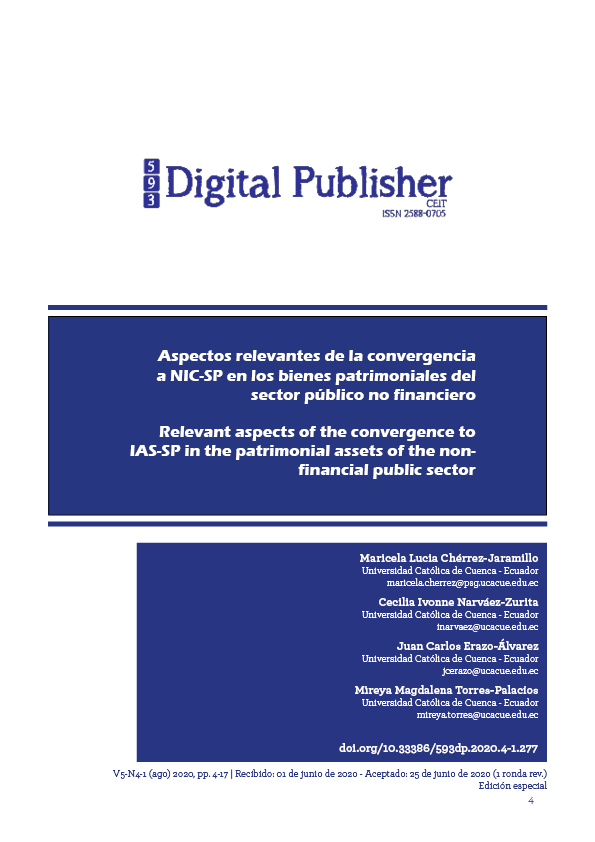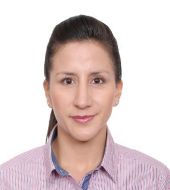Aspectos relevantes de la convergencia a NIC-SP en los bienes patrimoniales del sector público no financiero
Contenido principal del artículo
Resumen
Las Normas Internacionales de Contabilidad enfocadas al sector público (NICSP) emitidas por el Consejo de Normas Internacionales (IPSASB), constituyen estándares altos en la gestión de información financiera-contable. En la actualidad varios países del mundo han adoptado estos estándares, como es el caso de Ecuador. El presente estudio fue desarrollado en el Gobierno Autónomo Descentralizado Municipal de Azogues (GADMA), frente a la necesidad de reconocer y registrar los bienes patrimoniales en los estados financieros; el objetivo de la investigación consiste en plantear un proceso para la implementación de la NIC-SP 17 para el reconocimiento de los bienes patrimoniales. La metodología empleada en esta investigación fue de tipo no experimental y transversal, pues las variables se analizaron en su estado natural y en un solo momento del tiempo. En el diagnóstico se determinó la inexistencia de una norma específica que controle los bienes patrimoniales, su inventario fue levantado por última vez hace más de diez años por el Instituto Nacional Patrimonio y Cultural (INPC) y no por el GADMA, la gran mayoría de estos bienes no se encuentran bajo el dominio de la institución. Se concluye que con la implementación de la NIC-SP 17 se obtendrá información confiable para el reconocimiento de los activos de la Municipalidad los mismos que deberán ser registrados en la cuenta de Bienes de Patrimonio Nacional Histórico Artístico y/o Cultural como es el caso del cementerio Municipal, el Museo Rodrigo Pesántez y la Quinta San José; con ello la entidad presentará estados financieros razonables.
Descargas
Detalles del artículo
1. Derechos de autor
Las obras que se publican en 593 Digital Publisher CEIT están sujetas a los siguientes términos:
1.1. 593 Digital Publisher CEIT, conserva los derechos patrimoniales (copyright) de las obras publicadas, favorece y permite la reutilización de las mismas bajo la licencia Licencia Creative Commons 4.0 de Reconocimiento-NoComercial-CompartirIgual 4.0, por lo cual se pueden copiar, usar, difundir, transmitir y exponer públicamente, siempre que:
1.1.a. Se cite la autoría y fuente original de su publicación (revista, editorial, URL).
1.1.b. No se usen para fines comerciales u onerosos.
1.1.c. Se mencione la existencia y especificaciones de esta licencia de uso.
Citas
Banco Interamericano de Desarrollo. (2017). Estado de adopción de NICSP en los países de Latinoamérica y el Caribe. Banco Interamericano de Desarrollo. Auditora Independiente EY.
Contraloría General del Estado. (2016). Reglamento General para la administración, utilización, manejo y control de bienes y existencias del sector público. Quito, Pichincha, Ecuador: Registro oficial.
Deloitte Accountants . (2019). Las NICSP en su bolsillo (Vol. I). (S. A. Mantilla, Trad.) Bogota, Colombia: Deloitte Touche Tohmatsu Limited.
Dirección de Transferencia del Conocimiento Instituto Nacional de Patrimonio Cultura. (2011). Instructivo para fichas de registro e inventario de bienes muebles (Vol. 1). Quito, Pichincha, Ecuador: Ediecuatorial.
Dolores Ortiz Soto, C. N. (2019). Incidenciaen la aplicación de la NIC SP17 Propiedad, Planta y Equipo en las Empresas Municipales de Agua Potable. CIENCIAMATRIA , 1 (Volumen especial), 22.
Federación Intrnacional de Contadores- IFAC. (2003). NIC-SP 17 Inmuebles, maquinaria y equipos (Vol. 1). New York, New York, United States of Americas: IFAC.
FOCAL. (2019). CContabilidad Gubernamental en América Latina y convergencia a las Normas Internacionales de Contabilidad del Sector Público. Brasilia, Brasil: FOCAL.
Gad Muncipal de Azogues. (2016). Estatuto Orgánico por procesos. Azogues, Cañar, Ecuador: Registro oficial.
Glenda Mavel Lozano Calero, C. I. (2019). Procedimientos de control y registro contable bajo NIC SP para los activos del Gobierno Autónomo Descentralizado Parroquial de Fundochamba de la provincia de Loja. Visionario digital , 3 (2,1), 388.
IFAC. (2017). Manual de Pronunciamientos Internacionales de Contabilidad del Sector Público (Vol. 1). New York, NeW York, USA: IFAC.
Instituto Nacional de Patrimonio Cultural. (2014). Patrimonio Cultural Material. Loja, Loja, Ecudor: INPC.
Lobo, J. (2013). Medición y Valoración de los Activos bajo IFRS. Cartagena de Indias, Cartagena, Colombia.
Ministerio de Coordinación de la Política y Gobiernos Autónomos Descentralizados. (2017). COOTAD. Quito, Pichincha, Ecuador: V&M Gráficas.
Ministerio de Economía y Finanzas del Ecuador. (2019). Instructivo para la ocnvergencia de la Normativa de Contabilidad Gubernamental a NICSP a partir de 1 Enero del 2020 (Vol. Primera). (M. d. Economía, Ed.) Quito, Pichincha, Ecuador: Ministerio de Finanzas y Economía.
Ministerio de Finanzas del Ecuador. (2016). ACUERDO MINISTERIAL 0067 (Vol. 1). Quito, Pichincha, Ecuador: Ministerio de Finanzas.
Ministerio de Finanzas y Economía del Ecuador . (2019). Catálogo general de cuentas contables del sector público no financiero (Vol. 2). Quito, Pichincha, Ecuador: Ministerio de Finanzas y Economía del Ecuador .
Péres, O. V. (2018). Convergencia a Normas Internacional de Contabilidad para el Sector Público Nicsp: comparitivos de los modelos de Colombia y Chile. Javeriana , 01, 36.
Pincay, J. S. (2013). La Contabilidad Pública en América Latina y El Devengo en Ecuador. Analítika , 6 (2), 29.
Subsecretaria de Contabilidad Gubernamental. (2020). Instructivo para la Convergencia de la Normtiva de Contabilidad Gubernamental a NICSP a partir del 1 enero del 2020 (Vol. 1). Quito, Pichicna, Ecuador: Subsecretaria de Contabilidad Gubernamental.
Universidad de Costa Rica. (2018). Universidad de Costa Rica. (U. d. Rica, Productor) Obtenido de http://www.cicap.ucr.ac.cr/web/el-abc-de-las-normas-internacionales-de-contabilidad-del-sector-publico-nicsp-en-costa-rica-2/
Universidad de los Andes Venezuela. (2019). Elementos claves de las Normas Internacionales del Sector Público: Un aporte para el sistema de Contabilidad General . Visión Gerencial , 18 (2), 194.
Universidad Externado de Colombia. (2015). Metodología de reconomiento, valuación, medición y revelación de los bienes de uso público e históticos y culturas de acuerdo con la NICSP 17 en Colombia. Colombia.





